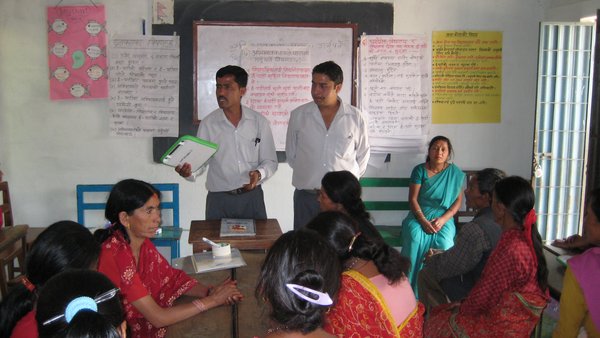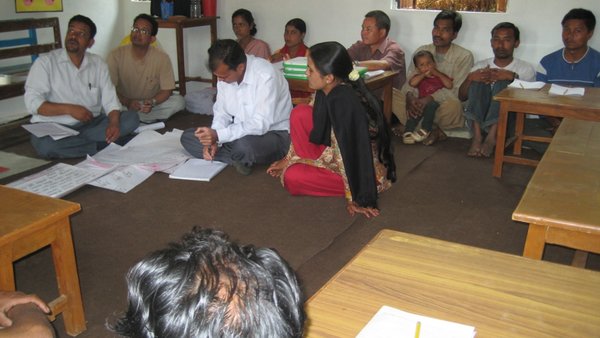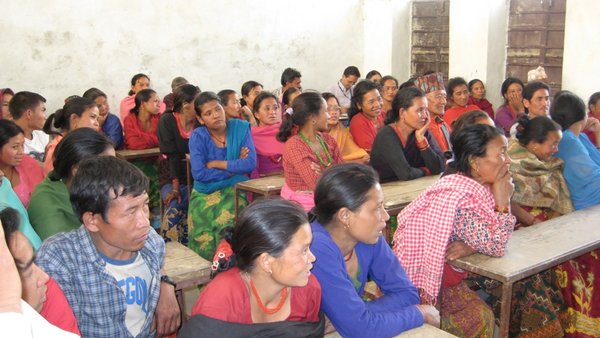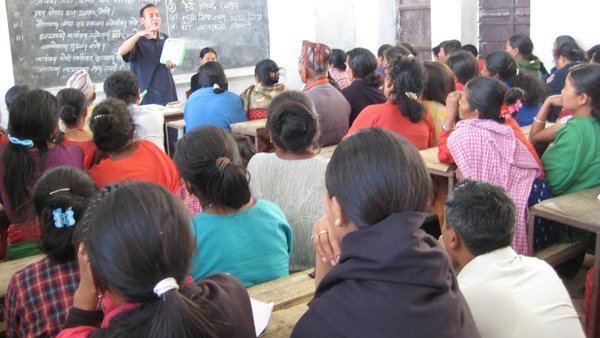Saurav Dev Bhatta
Introduction
We just completed an orientation program for parents and stakeholders at Bishwamitra Ganesh Lower Secondary School yesterday (April 21). A similar program was held at Bashuki Lower Secondary School last Thursday (April 17). The objective of these programs was to give the parents and other stakeholders in these test schools an overview of the project and discuss the importance of their role in making it a success. We strongly believe that the success of the project hinges crucially on the enthusiastic participation of parents and the larger community. Needless to say, the protection of the laptop is not possible without developing a sense of ownership of the project on the part of the parents whose children are getting laptops. At the same time, it is equally important to bring the rest of the community on board.
The programs were organized and conducted by the teachers themselves. As respected members of the local community, teachers are far more capable of garnering community support for this new idea than outside “experts.” Furthermore, this approach helps to drive home the idea that the project belongs to the local community.
Structure and Content of the Orientation Program
The program was designed to last for two hours from 11:00 am to 1:00 pm. Because of delays in participant arrivals and continuation of discussions, the program went on till 2:00 pm in both schools.
The following topics were covered during the program:
- Round of introductions
- Brief introduction to the project
- Discussion of the basic physical, emotional, and social characteristics of 2nd grade and 6th grade students and how this relates to the use and protection of the laptop
- Overview of the laptop (which was named E-Paati by the teachers themselves) and its functions
- Brief example of how the E-Paati is used in the classroom
- Educational benefits to students through the use of E-Paati in class and beyond
- Discussion session: Role of parents and guardians in the education of their children and in getting students to effectively use E-Paati
- Discussion session: Usefulness of the E-Paati to the rest of the family
- Discussion session: How to protect the laptop at home, in school, and when commuting to and from school
Rabi and I attended the orientation session as observers. Dev Mohanty and Sulochan Acharya were also present, though most of their time was spent working on the school network.
Photographs from the Orientation Program at Bishwamitra
Photographs from the Orientation Program at Bashuki
What We Observed
Here, I will only list some general observations.
- Overall, the teachers in both schools did a good job conducting the orientation program even though they had either very limited or no experience in conducting interaction programs with parents and other stakeholders.
- We now have no doubt that these types of orientation sessions must be conducted by the teachers themselves rather than by outsiders. The teachers clearly had a good rapport with the parents and stakeholders. In the case of Bishwamitra, the teachers belong to the local community itself—and this is a big strength of the school.
- All the children in Bashuki come from the Tamang community. We observed that the parents and stakeholders were more forthcoming in the discussions when they had the opportunity to talk in their native Tamang language rather than in Nepali. In the case of Bashuki, only one of the teachers—Neema—is from the local community. His active participation in the program was clearly very useful in getting the participants to actively engage in discussions.
- Bishwamitra did not have large enough rooms for conducting the orientation program in a single room. Furthermore, since the different classrooms were not sealed off from one another (due to lack of solid partitions), sound from one orientation room often drowned the conversation in the other room. This is typical of poor rural schools in Nepal, showing how difficult it is to conduct classes in such schools.
- The participants of Bishwamitra, in particular, were quite excited about the opportunities this project presents.
- As might be expected, stakeholders whose children were not in grades 2 and 6 (the only students receiving laptops in this test phase) were curious about when, if at all, their children would also receive laptops. There was some resentment as well. The teachers clarified that the program would expand to other grades if the test phase proved to be a success.
- The parents were quite concerned about the safety of the laptops, particularly during the students’ commute to and from school, as children have to walk through isolated forested areas (sometimes up to an hour) to get to school.
- At Bashuki, the parents discussed the possibility of "guardian-pooling," where guardians would form groups based on home location and take turns accompanying their children to school.
- In addition to guardian-pooling, the teachers at Bishwamitra also discussed implementing a strict rule requiring students to go home only in groups.
- In Bishwamitra, parents were also curious about whether it was wise for the rest of the family, particularly siblings not in class 2 and 6, to use the laptops. The teachers responded by clarifying that they want to encourage maximum use of the laptop and that the family should see it as a shared asset.



